A Better Difficulty II: Forza Motorsport 6
By gamer_152 2 Comments
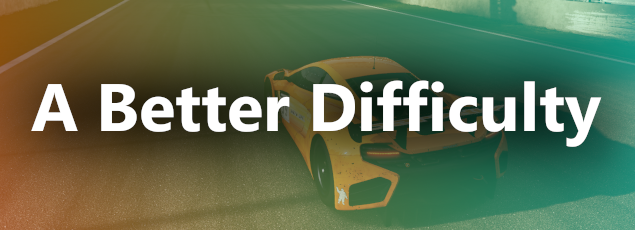
The appeal of punishing skill-based games like Dead Cells and Hollow Knight, and the accessibility of mainstream titles like Golf with Your Friends or Spider-Man (2018) look to be irreconcilable. We think the profound sense of triumph that we derive from those former games wouldn't come unless they punched us in the stomach time and again. If they didn't set the bar so high, we'd never see our skill level skyrocket as it does during these experiences. It follows that more casual players with less willpower and scant experience with games will not be able to clear that bar, and so, won't be able to feel the same sense of expertise.
And it's probably right that you can't build something that's exactly a Dark Souls for the general public. But I'd also argue that difficulty is relative and that the emotional appeal of masocore titles is fundamentally not down to them imposing some objective standard of performance. It's about them creating an environment in which we can see ourselves mastering an activity. When we start thinking of difficulty as something subjective and intrinsic reward coming with the right environment, we can imagine this empowering sense of mastery existing outside of a niche corner of gaming. We can recognise that these ideas appear in the medium on a much broader scale.
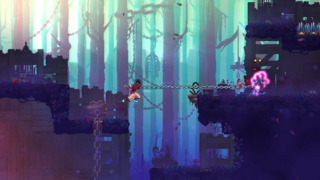
As I discussed in a previous article, a designer best helps players improve their skill when they:
- Make a difficulty system that accounts for the player having different skill levels at different activities.
- Incentivise players to take on more demanding tasks.
- Give players a safe space in which to experiment with a game's mechanics and interface. I.e. Not punishing them so severely that they are afraid to try new things.
- Allow players to practice the same tasks repeatedly.
- Let players adjust the difficulty of the game on the fly as they acclimate to challenges.
I'd add to these points a few common rules from game design that work to the same ends:
- The player should generally have a clear idea of the actions they need to take to succeed. E.g. In many platformers, such as Ristar, the exit to the level is on the right of the stage, so the map layouts generally signal that we should move to the right to progress. Simultaneously, spikes signal regions of the environment into which we should not move.
- The game should give the player clear, immediate feedback about the quality of their performance. E.g. In shoot 'em up, Gradius ReBirth, if we inflict damage to an enemy, a red explosion appears where we hit them. If our shot fails to make a dent because the enemy is invincible, we see a blue explosion where our round landed.
- The player should have a clear idea of alternatives to their current approach, especially when failing. E.g. In an RTS like Total Annihilation, if the soldiers we've deployed start dying off, we can open a panel full of other units to place on the battlefield instead. However, in many text adventures, such as Planetfall, the problems are unsatisfying to solve because we don't know the set of actions available to us. We can only use trial and error to see which written commands the game does or does not respond to.
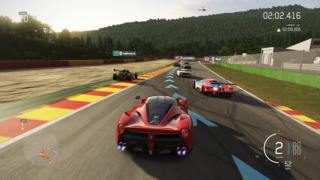
One of the most recognisable instances of a game series hitting these points and the five mentioned above is Turn 10's Forza Motorsport. When I started playing Motorsport 6 earlier this year, I felt comfortable with the game but didn't have a handle on the simulation elements. I'd never learned how to manually shift in the Forza games, and I wouldn't play without Assisted Braking on. However, the difficulty settings and feedback loops of Motorsport 6 meant that all that changed.
In my last blog, I mentioned that traditional difficulty settings are of limited use because there are many areas of challenge they don't operate on. The line between arcade racers and racing sims is a product of the restricted scope of typical difficulty settings. In any one driving game, we might be able to tweak the abilities of our opponents. However, if we wish to experience different levels of mechanical complexity or significantly different vehicle handling, we have to play an entirely different game. The menu options just do not exist in a Horizon Chase Turbo to turn it into an F1, nor do the options exist in an F1 to turn it into a Horizon Chase Turbo. Forza eliminates the dichotomy between sim racer and arcade racer by allowing us to mix and match elements of both.
In Forza, setting the game to Easy, Hard, or any other difficulty does more than just determine the aptitude of other drivers. It adds or removes mechanics from play and transforms the handling model of our vehicle. The menus in which we control these changes explicitly clarify what underlying gameplay elements each difficulty option alters and how it alters them. In Motorsport 6, if we switch the game from Hard to Veteran, we can see Stability Management turns off. If we move from Medium to Easy, we can observe the Steering shift from Normal to Assisted.
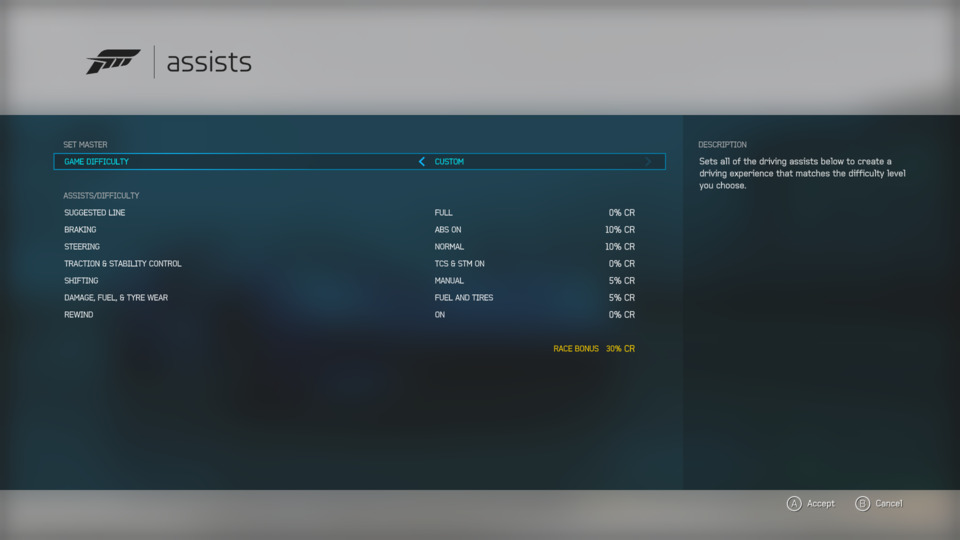
We can also set every one of these difficulty components individually, allowing the game to accommodate our unique skillset and tolerance for challenge. E.g. If we have a knack for knowing just when to brake but struggle to control our rotation and speed simultaneously, we can disable ABS but activate Automatic Shifting. If we're often left in the dust but have an irresistible urge to improve, we can set the AI drivers to "Highly Skilled" but turn the "Rewind" mechanic on. In all cases, the game gives a detailed text description for each setting, leaving no ambiguity about the function of the menu elements. For example, this description of the "Simulation" setting for Steering:
"Simulation steering eliminates any damping and steering speed assistance for a more realistic, one-to-one effect, making counter-steering much quicker. Please note this mode is difficult with a controller, and is recommended for advanced players".
Or this one for the "Fuel and Tires" setting for "Damage":
"Cars will show the appearance of damage, but there will be no physical effects. Tires wear out based on your driving technique, and fuel is consumed as you race".
In most titles, the difficulty is a dial that the player turns, but Forza makes it a mechanical configuration that they construct. The player makes choices about the difficulty that a designer traditionally would. That creates a workload that the most casual audiences may baulk at, but when accomodating the specialised and demanding challenges of something like a racing sim, this control over types of difficulty can be perfect. Instead of the designer trying to assume the player's skills and setting up challenges to match, the person who best understands the player's talents: the player themselves, can set those challenges.
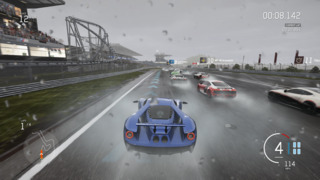
Like most games, Forza lets us experience an increase in difficulty over time. However, unlike in most games, in Forza, the bulk of the potential difficulty increase derives not from hardcoded curves toward the unforgiving but from the player pushing themselves by adjusting the difficulty options. XP and currency bonuses exist for those who amplify the hardships, incentivising them to take on greater and greater challenges. The framing of these bonuses is also integral to that encouragement. It is not that the driver receives a penalty for keeping "Assists" on; it's that they get a reward for turning them off. This tells newbies and casual players that the way they're competing is valid while still giving them a reason to develop their skills and rewarding their efforts when they do. Different car classes and novel tracks further encourage drivers to step up their game. For example, you may be able to corner with Traction Control off when you're driving a cooperative hatchback, but doing it in a prototype Formula One vehicle might take some training. You might think that you can overtake other drivers perfectly on dry ground, but what happens when you try to run the same courses in the rain?
Note that Forza and most other modern racing games will credit you with success, even if you don't come first in a race. If that weren't true, you would be motivated to set the difficulty low to guarantee a win and the rewards that come with it. Through using that strategy, you wouldn't push yourself. In Motorsport 6, even losers can earn decent prizes, making the user more secure in their experimentation. And coming anywhere from first to third counts as a success. So, you are incentivised to put yourself in a position where another car or two has a good chance of overtaking you and clinching first. If you're competent, you have a solid opportunity of succeeding at a race while likely having further obstacles to overcome, allowing you to improve your skill safely.
Forza Motorsport 6 also uses its Mods system to dangle additional carrots in front of players who heighten the difficulty. In each race, the player has three "Mod" slots to fill with cards from one of three categories:
- Boosts are consumables that amp up the rewards at the end of a race or bolster your vehicle's performance in that race. For example, giving a +60% credits bonus or moving you up two places in the starting grid.
- Crew are non-consumable add-ons that improve your vehicle. For example, by adding 10% more horsepower or reducing weight by 7 points.
- Dares are non-consumables that amplify your rewards in exchange for lumping you with some disadvantage. For example, a +10% credits payout for increasing the time it takes to shift gears by 0.5 seconds or +30% credits if you play with the camera locked to your front bumper.
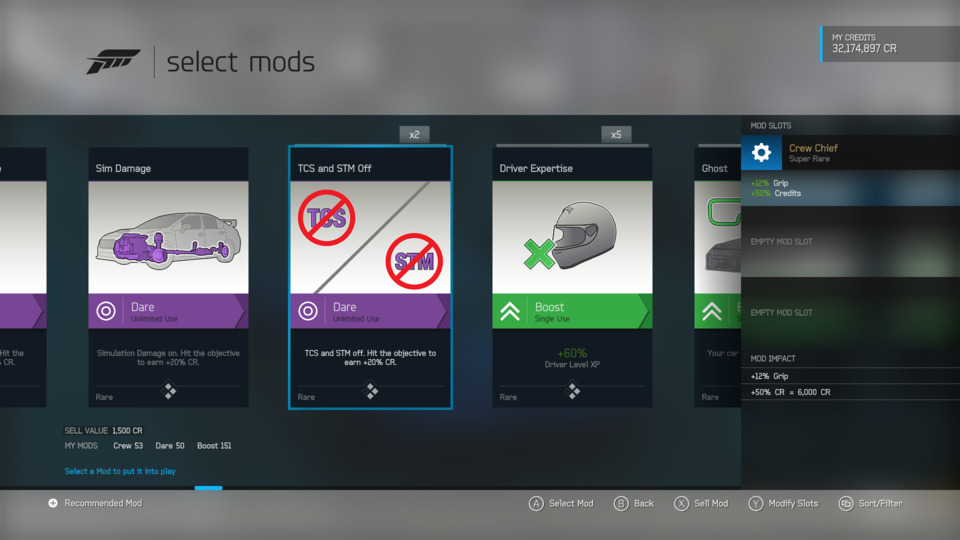
We can see plainly how a Dare encourages the player to adapt to new challenges, but in truth, all the Mods work to tempt us into making the game that bit harsher. They are another means through which the design frequently prompts the player to modify the difficulty and sand the edge off some of the more taxing difficulty changes. Maybe I wouldn't normally be able to take corners with Assisted Braking off, but if I have a Boost or Crew member that can upgrade my car's grip, I might give it a try. Perhaps Expert AI would generally be able to thrash me, but if I can move myself to the front of the grid, I might give beating them a shot.
Motorsport 6 does make a couple of conspicuous blunders in trying to lure us towards mastering its mechanics. Problem one is, oddly, one we also saw in Luigi's Mansion 3. It's that it just doesn't give the player much to spend their money on. I'm no Lewis Hamilton, but by about two-thirds of the way through the career mode, I had more cash than I knew what to do with. The lack of a home for these credits is disappointing. If increasing the difficulty generates more money, but earning more money gives diminishing returns, there's a diminishing incentive to increase the difficulty. You might think, "at least when the player makes races harder, they still get more XP, keeping them on the right track in developing their skills". You wouldn't be totally wrong about that; XP can be gratifying to earn without it unlocking any further rewards. However, where it does hook into the larger systems, XP translates into level increases, which translate into:
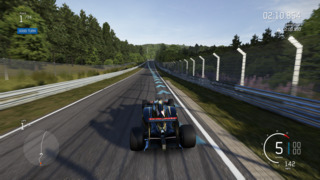
- More cars we might not need.
- Credits which, as we just mentioned, become superfluous.
- Mods that effectively convert back into XP and money.
There may be no fix for this. The cars in the modern Forza games are priced within a casual player's reach. It makes it that everyone can experience a variety of automotive experiences, including driving the most prestigious vehicles, without having to grind. And if the developers implemented too many RPG-style upgrades for the player to spend their income on, the game would stop being a test of their skill and primarily reward sheer time spent in the software.
Problem two: It's too easy to get cosy with a particular Dare and Crew member and slot them in for every race at the exclusion of all others. Once we find an ideally profitable combination of Mods, we have no reason to vary our Mods, and thus, the scope of our challenges becomes much smaller. We end up in a comfort zone where we are not testing ourselves, and therefore, suspend our development as a racer. Fortunately, unlike problem one, problem two has realistic solutions. If Crew and Dares were consumable, or if their effects tapered off when used many times in a row, we would have a reason to change up our racing style.
Despite these two shortfalls, the game ticks off our first and second bullet points for how a designer should treat difficulty. It acknowledges the multi-faceted nature of skill and responds to it, and it incentivises us to grow those facets. But what about the next three: Giving the player a safe environment to experiment in, allowing them repeated practice of the same manoeuvres, and letting them change difficulty on the fly? We haven't spent as long discussing these requirements. Most obviously, Motorsport 6 represents these ideas in enabling us to alter the challenge between races. Less obvious is how Forza's UI and structure regularly invite the player to modify the difficulty even sans Mods. In many single-player games, there is no option to alter difficulty without starting a new save file. Others let you change it at any point but nestle that option away in a menu that you'll probably never look at.
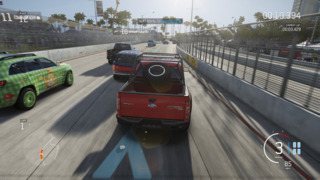
As a racing game, Forza is split into discrete play chunks of play: races. The downtime between races constitutes a natural rest period in which we might reconsider our difficulty settings and modify them based on our previous performance and expectations of upcoming challenges. It's not unlike how a real racing team might retune a car for a specific race. We might note that the upcoming race will be a sprint, and so, turn up the AI intelligence. After all, if we fail the race, we won't have spent too much time on losing. We could see that the next event will be held at night when friction on the track is much lower, and so, turn traction control on. For more dedicated players, literal tuning is also something they can do to make their vehicle play into or against their strengths.
Motorsport 6 could deliver us seamlessly from one race to the next. Instead, before every race, we see a menu in which the "Start Race" buttons sit alongside difficulty options. The buttons to change difficulty are only ever a few presses away from "Start Race", and selecting them is a choice suggested to us with literally every event we play. In the current Forza games, the player winning or losing multiple times in a row also causes the game to ask whether they want the AI capability bumped up or down a level.
Most video games see difficulty as a modifier that applies permanently, or at least, to one playthrough of a game. Forza presents difficulty as something that need only apply to the current race you're competing in. When you think of difficulty in these volatile terms, experimenting with it doesn't feel like a big deal. If you go overboard and make the game too hard in one way or another, you can always turn it back down the next time or even hit "Restart" if your race has gone totally sideways. The options are right there, and the game presents them with enough regularity that you are always conscious of them.
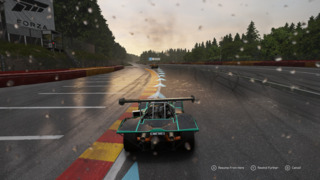
The power to alter the rules of each race lets us practice with different challenges on the macro-level, but it's the game's "Rewind" mechanic that makes the same possible on the micro-level. If we have the "Rewind" Assist turned on, then we can press the Y button to turn time back a few seconds at any point during a race. It's perfect for if we spin out or veer off the track. It's, again, an example of how more security can expand the extent to which the player can experiment with challenge, and therefore, hone their skills. I was able to learn manual gear shifting and to drive without Assisted Brakes because of the Rewind mechanic. It let me take the same turns over and over, with these rules in play, until I got my inputs right.
The difference between how the player paid for their Rewinds changed between the fifth and sixth entries in the series. In Motorsport 5, you took a haircut on your end-of-race credits for the number of times you rewound during a race. In 6, you effectively pay a flat rate and then can use the Rewind as many times as you want without incurring further penalties. I'm not sure that either of these is the "right" approach, but it is relevant to note how they bring out different player behaviours. Under 5's system, you're encouraged to wean yourself off of the Rewind slowly but never entirely untie that safety net. You do receive more reward for using the Rewind only three times a race as opposed to five, but when it's always an option just to turn back time, you may not learn to drive without it entirely. As 6 implements the mechanic, you don't have a push to gradually reduce your use of Rewind. Using a Rewind once in a race or twenty times leads to the same reward output. However, there is a greater incentive to learn to go without it entirely, trading the handicap for a 10% reward increase.
Note that while there is no formal option to set the number of times you can use the Rewind mechanic, this is one area where you can make an implicit decision about the game's difficulty, utilising the Rewind as much or as little as you want. While this mechanic may at first appear as a cheat that removes challenge from the game, notice that it can never perform the required manoeuvres for the player: the player must always demonstrate that they can do them on their own. The Rewind mechanic only changes the number and frequency of opportunities the player gets to take any one turn or straight.
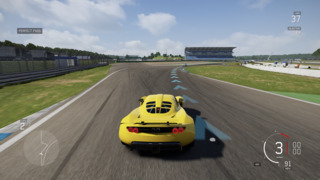
The Rewind works in harmony with the mechanic most associated with Forza: the Driving Line. In many racing series, including this one, precision performance is about controlling and exploiting your car's momentum. You want to slow for corners instead of trying to speed through them and overshooting. You need to slingshot yourself into curves in the track, allowing the weight of your car to propel it forwards even as it brakes. There is an invisible line in racing games that represents the optimum path that the player should cut through the circuit. But if it is invisible, how is a rookie player meant to learn to follow it?
Forza gives us the option to make the "Driving Line" not just an abstract construct in the play but a visual indicator on the course. This guide is, by default, blue, but fades into yellow to show when to relax the accelerator and red to display when to brake. The player can modify the difficulty to get the full Driving Line, have it only appear for braking sections, or turn it off entirely.
As with the Rewind, it's easy to get sucked into seeing the Driving Line as some kind of hack. In practice, this is never the case. Just as enemies in an FPS mark where we should shoot, the Driving Line tracks the space we must angle our vehicle into. But in both situations, a sense of challenge is retained because it's one thing to know what we should be doing, and another to have the hand-eye coordination and physical awareness to pull it off. The Driving Line cannot tell you how much pressure you need to apply to the left stick or how long you need to hold it to stay on route. It cannot tell you the optimal moment at which to accelerate out of a turn. It can't tell you when to shift gears up or down, and if you come off the Line, there's no guide on how to get back on it.
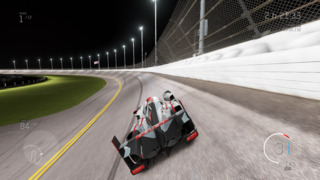
Circumstances sometimes make it so that you cannot magnetise your car to that Line even if you are in perfect control of your vehicle. Glare on the asphalt can obscure this UI element, or it can lead you through a puddle you'd rather avoid. Frequently, an opponent is driving through the space it occupies. Like Forza's other Assists, the Driving Line does not arbitrarily loosen the difficulty. Instead, its job is to fill in the gaps in our tasks, reducing the steps we need to perform to succeed.
The Driving Line and Rewind work hand in hand with Forza's most explicit form of feedback. When we skid around a corner, the game will tell us "Good Turn" if we stayed roughly on the Line or "Perfect Turn" if we matched it exactly. Imagine receiving this criticism without being able to see the Driving Line. You'd know when you've made a "Perfect Turn", but without knowledge of the invisible route, you'd struggle to form an understanding of what a "Perfect Turn" means. Many games harbour this issue where they'll tell you if you made the right move but don't tell you what about it was right, hampering you from replicating it in the future. Motorsport 6 can show why it was correct and shouts out equivalent ratings for your drafts and drifts. Although, it does not lend similar guidance on how to execute those last two feats properly.
Let's summarise by taking our list of ideal design principles for training the player and match them against the Forza mechanics that implement those principles:
| Principles | Mechanics |
|---|---|
| Account for the player having different skill levels at different activities. | Modular difficulty settings, Mods. |
| Incentivise the player to take on more demanding tasks. | Instinsic reward, XP, monetary rewards, finishing higher on the podium. |
| Give them a safe space in which to experiment with the mechanics and interface. | Rewind, splitting the game into races with discrete difficulty settings. |
| Allow them to practice the same tasks repeatedly. | Rewind. |
| Let them adjust the difficulty of the game on the fly as they acclimate to the challenges. | Splitting the game into races with discrete difficulty settings. |
| The player should generally have a clear idea of the actions they need to take to succeed. | Straightforward mechanics, Driving Line. |
| The game should give the player clear, immediate feedback about the quality of their performance. | Turn Ratings, Drift Ratings, Draft Ratings, Driving Line, player position in race. |
| The player should have a clear idea of alternatives to their current approach, especially when failing. | Foregrounding difficulty options, prompts to change difficulty, Driving Line. |
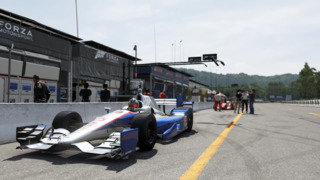
Of course, the Forza mechanics don't port well to most games outside the racing genre. However, the important detail here is that the bullet point principles they represent boost the player towards mastery, aiding them in overcoming obstacles without eliminating challenge. Such principles transcend any one game format. Thanks for reading.